14 Common Egg-Poaching Mistakes You Might Be Making
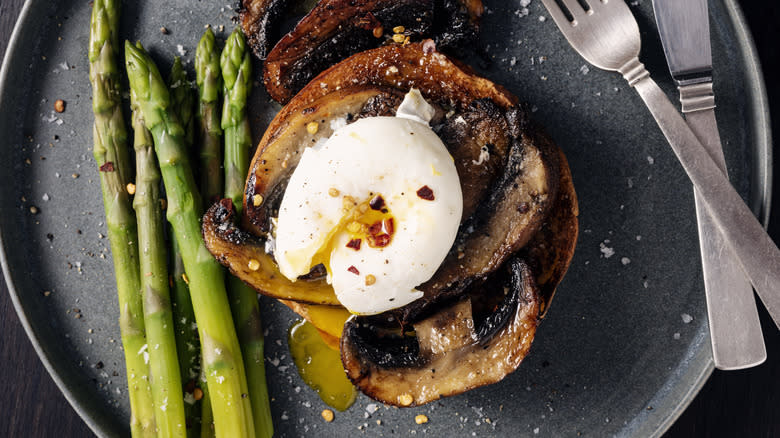
Of all of the ways to cook an egg, poaching might be the most frightening, and we can understand why. A classic French cooking technique, poaching an egg involves submerging it in warm liquid until it's just set. When it's done correctly, the egg yolk remains golden and runny, the egg white is firm, and the whole thing is contained in a snug, spherical shape. Getting this just right, though, requires a combination of delicacy, preparation, and control, and just one misstep can result in your egg going drastically wrong.
Mistakes can occur at virtually every step of the egg-poaching process. From setting your heat too high and inadvertently simmering or boiling your egg, to dropping it into the water from the wrong vessel and causing it to spread or the egg yolk to burst. Your choice of pan, how you prepare your water, and the quality of the eggs themselves can make a big difference to your ultimate result. Sounds daunting, right? Well, that's because it kind of is. Don't worry, though: By steering clear of the common mistakes people make when poaching eggs, you can ensure that your eggs Benedict come out just right every single time.
Read more: 14 Liquids To Add To Scrambled Eggs (And What They Do)
Using A Pot That's Too Shallow
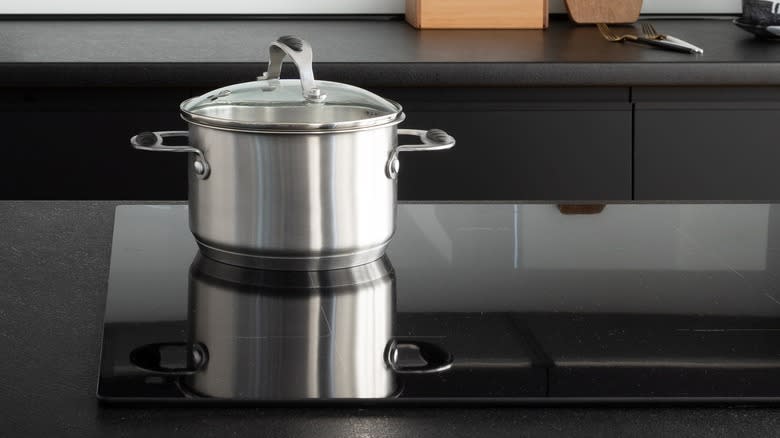
While you may have seen some people poaching their eggs in a shallow pot or frying pan, we heartily recommend you avoid following their example. Poaching eggs in a deeper pot, and giving them more water to cook in, gives you a more aesthetically pleasing result and a more evenly poached piece of food. When you place an egg in a deeper pot of water, the yolk sinks further and the white encloses around it from above, creating the ideal sphere shape. If your pot is too shallow, the yolk will plonk onto the bottom, and the white will spread to either side, giving you a wider, flatter result.
This depth also allows water to cook the egg from every angle, which firms up the whites at the same rate, as opposed to the egg sitting on the bottom of your pan and cooking unevenly. There's also the risk of your egg becoming stuck to the bottom of your shallow pan, which can cause issues when you come to remove it and find that it's stuck. We recommend having at least 4 inches of water in a poaching pot. You should also make sure your pot is wide enough for the water to circulate your eggs properly.
Poaching Old Eggs
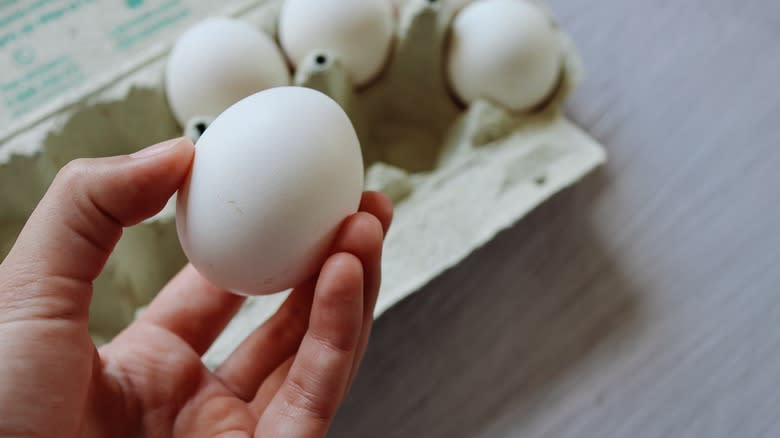
It can be difficult to tell how old an egg is. Sell-by and expiration dates on egg cartons aren't subject to federal regulations in the U.S. (and aren't allowed in certain states), and if you've removed your eggs from the carton, it's anyone's guess as to when they should be used. This can create a problem when it comes to poached eggs, as the older the eggs get, the less able they are to retain their shape once they enter the water. As eggs age, their whites become more watery, and this can make them spread out and "feather" in your poaching liquid, ruining the spherical shape you're aiming for.
Therefore, you should always use eggs that are as fresh as possible for the best result. How to tell if eggs are bad or not, however, is sometimes not as simple as assessing their visual appearance or texture. The best way to do it without cracking them open is to place your eggs in a bowl of water. Super-fresh eggs will remain at the bottom of the bowl, lying on their side. If your eggs stand upright, they've started to get older -- and while they may still be okay for some uses, they might not be ideal for poaching. If your eggs float, it's a sign that they might be unsafe to eat, and you should throw them out immediately.
Trying To Poach Them With Boiling Water
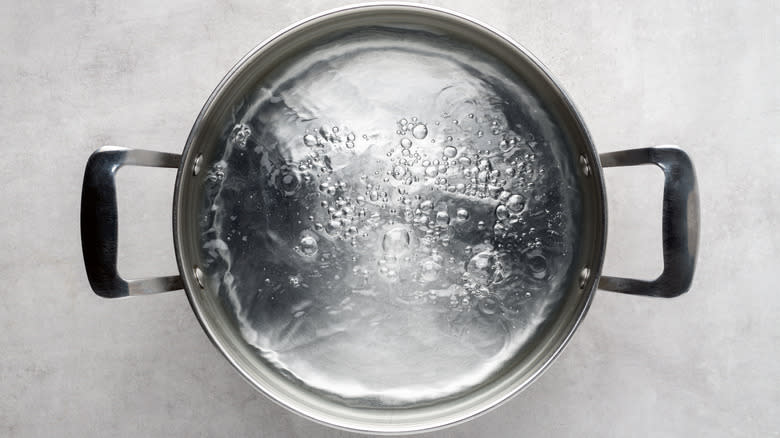
Working out how to poach an egg perfectly every time takes a lot of trial and error. The first thing you need to nail, though, is the temperature of your water. Turning your heat up even a bit too much will cause your water to boil, which is precisely what you don't want with a poached egg. When this happens, everything cooks too quickly and vigorously, and you end up with an overly hard egg with a firm yolk. The action of the bubbles can also lead to a misshapen egg, which ends up flat or lumpy instead of rotund and plump.
Ideally, your water's temperature should be between 180 and 190 degrees Fahrenheit. The easiest, and most accurate, way to check this is with an instant-read thermometer. If you don't have one, though, you can guesstimate its temperature by its appearance. When water is ready to poach, it has a shimmering quality and will look as though it's about to start bubbling, but it won't have any of the bubbles produced by a higher heat.
Forgetting To Add Vinegar
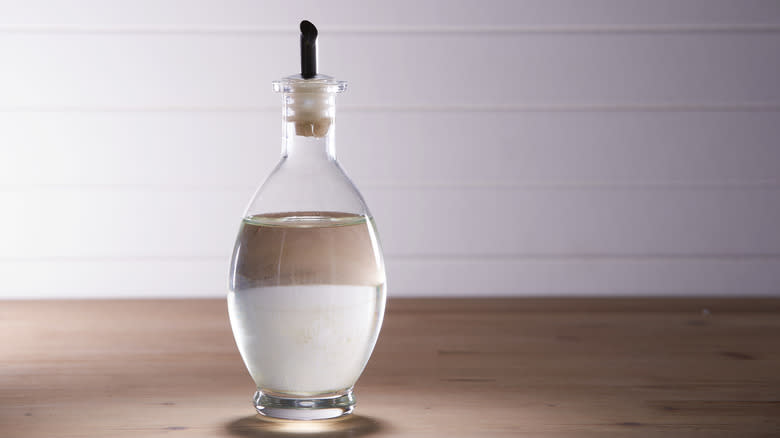
One of the biggest issues that occurs when poaching eggs is their spreading when they hit the water. When this happens, your eggs can solidify in elongated, stringy shapes and not maintain the roughly spherical look of a perfectly poached egg. One of the best ways to avoid this is by adding vinegar to your poaching water. Vinegar helps the egg whites denature more rapidly, which essentially means that they coagulate and cook quicker. As a result, your eggs are more likely to hold a tight shape.
It's important to remember that you don't need that much vinegar in your pot to achieve this effect. Around a tablespoon per large pot of water will be plenty. If you don't have vinegar, you can use lemon juice instead: They're both acids and will have the same effect. Crucially, keep in mind that adding either vinegar or lemon juice will alter the taste of your eggs ever so slightly, so if using the former, it's best to go for a lighter-tasting white vinegar. If you find that the flavor changes too much, try using half the amount next time, or consider omitting it entirely.
Using Eggs Straight From The Refrigerator
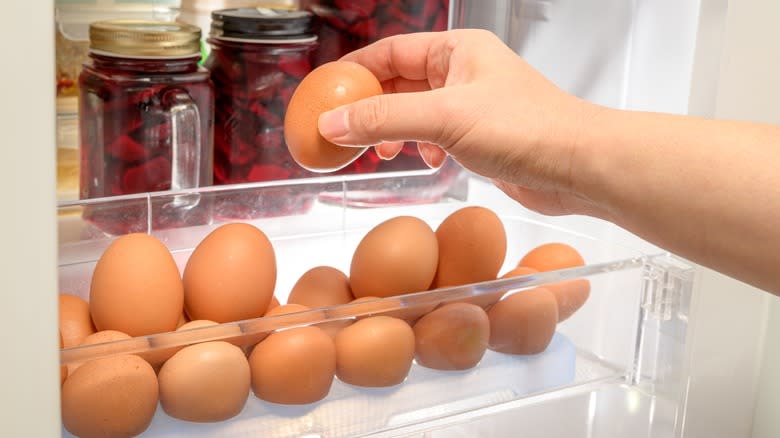
Eggs are one of those foods that you have to refrigerate, to keep them fresh for longer and prevent foodborne bacteria from growing in them. However, when it comes to making poached eggs, you'll want to pull them out of the fridge ahead of time. The ideal temperature for a fridge is 40 degrees Fahrenheit or slightly lower. When eggs that are cooled to this temperature hit the poaching liquid, they inevitably bring the heat down quite considerably. Not only does this make the process take longer, but it can also lead to unevenly cooked eggs, or the temptation to crank up the heat to bring everything back up to temperature -- which can cause them to suddenly overcook.
Make sure you take your eggs out of the fridge around half an hour before you're planning on using them. If you were storing them in their original carton, they may take slightly longer to warm up. Bear in mind that you probably won't want to take them out too far in advance, as they can start to become unsafe to consume within two hours (or in under an hour if your kitchen is 90 degrees Fahrenheit or hotter).
Cracking Your Egg Directly Into The Pot
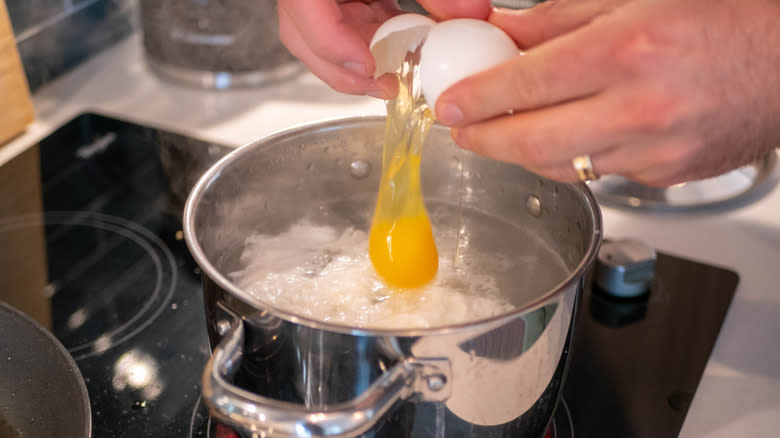
How your egg enters your poaching pan can make an enormous difference for your final result -- and if you've ever seen chefs delicately plopping their eggs in from a ramekin hovered just above the water, there's a reason why. Cracking your eggs directly into the pot opens you up to a world of potential problems. The first is the potential for your egg to become misshapen: Instead of your egg entering the water in one easy package, cracking it in can cause it to drip or the yolk to be left behind, giving you an unsightly, badly cooked piece of food.
Cracking your egg can also break the yolk, which is something that you want to discover before it enters the water and solidifies into a chewy mass. Then there's the shell itself to consider. Most people are familiar with a piece of shell ending up in their food when they crack an egg, and when that piece is in nearly boiling water, it becomes more difficult to remove. Cracking your egg into a ramekin first can help you avoid all of these pitfalls.
Not Swirling Your Water
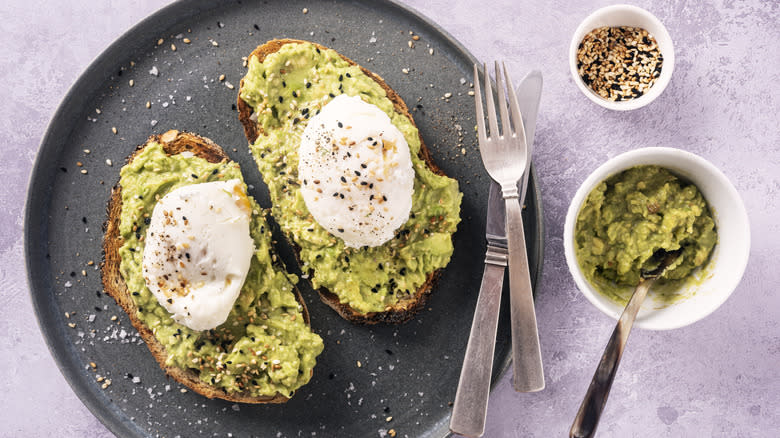
When making a poached egg, cracking it into unmoving water can cause it to feather out and lose its shape. This leaves you with a flat poached egg where the white has pulled away from the yolk, causing it to cook unevenly and potentially lose its runniness. Swirling your water before cracking your egg into it, though, can help it keep its shape. Simply swirl a spoon around inside the pot in a clockwise motion to create a vortex effect before pouring your egg into the middle. Once the egg's in, the water continues to spin around it, which will cause the white to wrap around the egg yolk and keep its shape.
Bear in mind that this will work well if you're only poaching a single egg, but if you're poaching multiple, it might be less useful. Because the whole point of this trick is that you drop your egg in while the water's still moving rapidly, it can be a bit of a juggling act trying to get all your eggs in at once while maintaining the vortex's speed. You might also find that pouring your eggs in at non-central points alters their shape and potentially spreads them out.
Forgetting To Strain Your Eggs
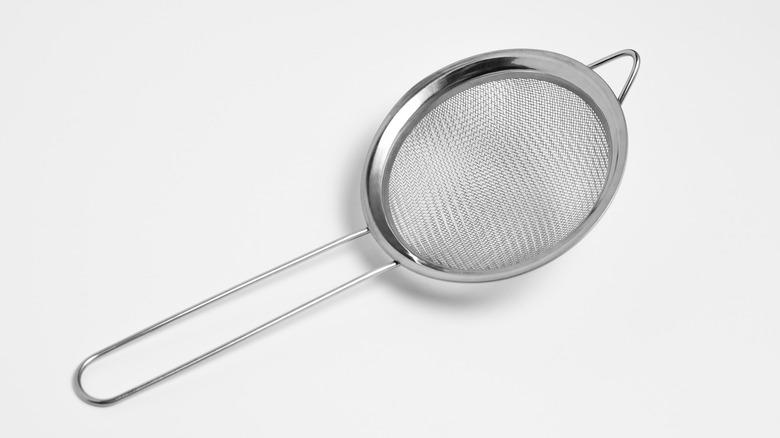
You know that small, handheld strainer -- the one that you bought a few years ago to sieve some baking soda for that one recipe and never used again? Turns out, it's pretty useful for poached eggs. Straining your eggs before you poach them can help drain away excess albumin, which gives you an altogether prettier and more consistently cooked egg.
Eggs are made up of many different parts, including several different albumins. When you strain an egg, the outer albumin (which tends to be runnier, due to its higher water content) is drained away. The middle albumin, meanwhile, remains intact around the yolk, as it's thick enough to not move through the strainer's holes.
When you then poach your strained egg, it doesn't end up with those feathery edges that ruin its appearance and your breakfast. Instead, the egg white will remain much more spherical and attractive looking, as well as more solid and less watery. You also end up with a better white-to-yolk ratio. Poaching isn't the only technique you should be straining your eggs for, either: Doing so before frying your eggs will give you an altogether better result.
Trying To Poach Too Many Eggs At Once
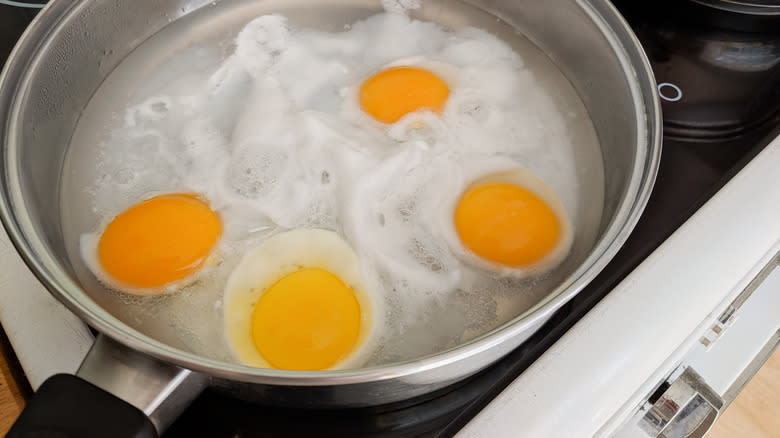
Poached eggs are the perfect brunch food, and if you have a bunch of friends coming over, it's natural to want to streamline your process for cooking them. However, poach too many in one go at your peril. Poached eggs need a sufficient amount of room to cook properly, allowing the water to circulate them consistently. If you add too many into one pan, this water circulation is tampered with, and the eggs cook poorly.
Cramming too many poached eggs into one pan can also cause them to stick together, which can provide a real headache when you're trying to separate them -- and which can lead to them splitting open. It's also worth remembering that poaching an egg requires a fair bit of close attention, and you need to pull it out at just the right time to stop it from overcooking. If you're trying to manage loads of eggs at once, it's easy to lose focus, and you risk ruining them all. There's nothing wrong with cooking several poached eggs at once, of course, but just make sure you have a big enough pot.
Only Poaching Them On The Stovetop
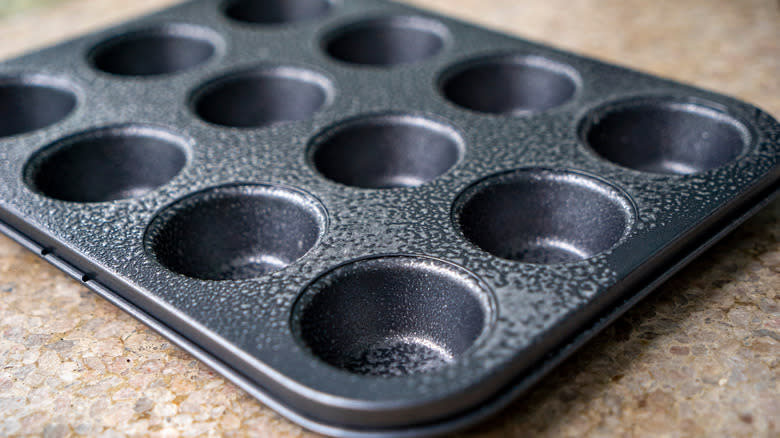
Let's face it, people: Poaching eggs can be hard work. One of the biggest mistakes people make, though, is assuming that the difficult way -- the stovetop method -- is the only way to cook them. You can produce a poached effect for your eggs by cooking them in several different styles, and if you're looking to mix it up, it's worth making muffin tin poached eggs.
Although these eggs are technically baked instead of poached, the method produces a near-identical effect, without the hassle of a big pot of boiling water. You simply crack one egg into each muffin tin space, after adding a tablespoon of water to each hole. Season and then pop them in the oven. The dry heat of the oven helps to cook the eggs consistently, while the added water produces steam, helping them to remain soft and tender. One particular bonus of cooking eggs this way is that each one comes out the same shape and has the perfect dimensions for popping on an English muffin. If you're just cooking for one, you can also try a microwaved poached egg by blasting it in the microwave in a mug filled with water.
Salting Your Poaching Water
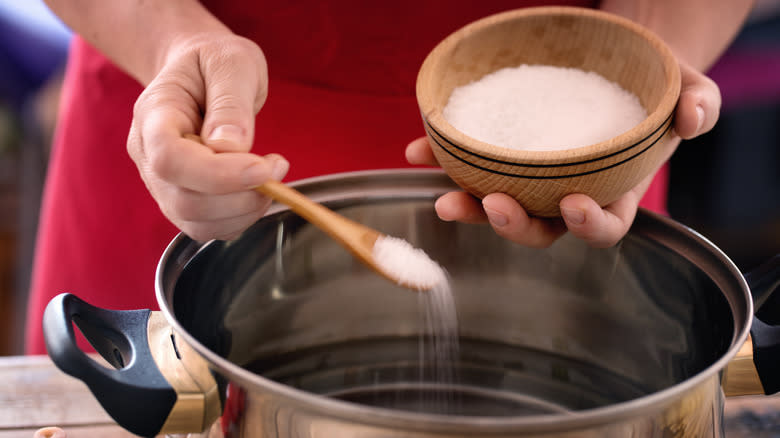
Adding salt to cooking water is a common practice for foods like pasta, but somewhere along the line, we started doing it whenever we could. This means that adding salt to poaching water for eggs has become a somewhat common practice. We're here to tell you, though, that doing so can affect your egg's structure fairly considerably. Salting your poaching water can cause your egg whites to loosen, and this can result in wispy, feathery edges. This may not ruin your egg outright, but it'll certainly affect its appearance and potentially its firmness.
Adding salt to your poaching liquid can also affect the flavor of your egg. While you might think that this could result in a seasoned, balanced effect, what happens is that the eggs taste briny and unappetizing. It's far better, therefore, to hold off on the salt until your egg's out of the water. Using a sprinkle of crunchy sea salt will not just give your eggs the pop of flavor they need just before serving but add a touch of delectable crispiness, as well.
Removing Them At The Wrong Time
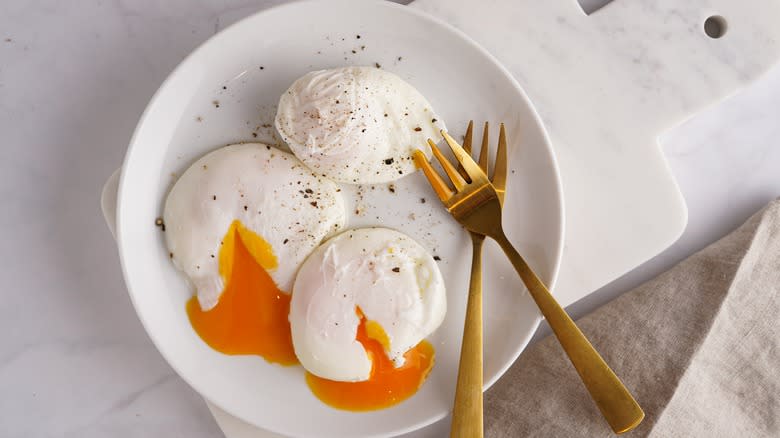
Eggs can be cooked in a million different ways, and everyone has their preference about how firm their egg is. With poached eggs, though, there tends to be slightly less variation around this -- the emphasis is on getting the perfect balance of a set white and a flowing yolk. Unfortunately, this is a bit more difficult than it seems and requires you to pull the eggs out of the pot at just the right time. Leave them in for too long, and the yolks start to cook, losing their unctuous creaminess. Pull them out too early, however, and the whites will still be runny, with an unpleasant, gooey stringiness.
Luckily, there's an easy way to figure out whether your eggs are done: Give them a poke. Pull one of your eggs out of the pot, allowing the water to drain away from it, and then poke it lightly with your finger, assessing its firmness. If it still has a good jiggle to it, but the white is looking fairly firm, then it's in the right place. If the white still looks a little glossy or is sticky to the touch, it probably needs another few minutes.
Using The Wrong Utensil To Take Them Out
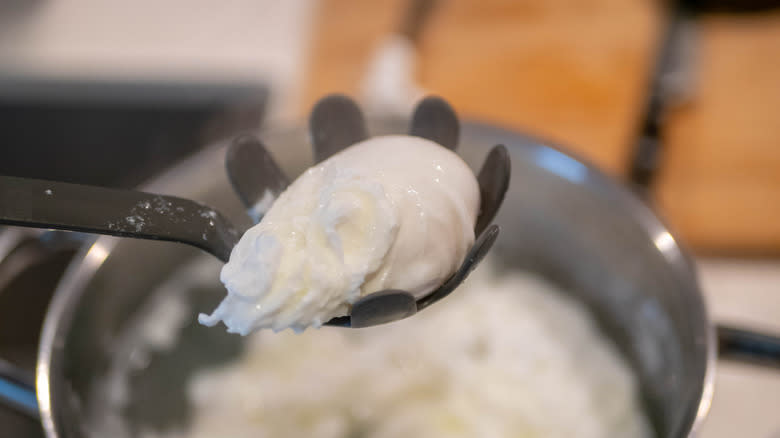
One of the worst tragedies that can befall a poached egg is when it ends up too watery -- and more often than not, that's not because of how you cooked it. Remove your egg from the pot with a closed utensil, and you'll end up taking a bunch of cooking water with it. Some of this water will steam away, but you may still end up with a certain amount being dumped onto your piece of toast, ruining your breakfast.
Nailing your utensil game will help prevent this. If you're using a spoon, you should always make sure it's slotted. This will allow the water to drain away from its bottom, leaving your egg nice and dry. You can also cut out the middleman and poach your egg directly in an egg poacher, a small, curved piece of metal with holes punched in it, which simultaneously helps to keep the egg's shape and keep it dry when you pull it out. If you want to make sure your poached egg is totally dry, decant it onto a piece of paper towel before serving it.
Not Using Cling Film
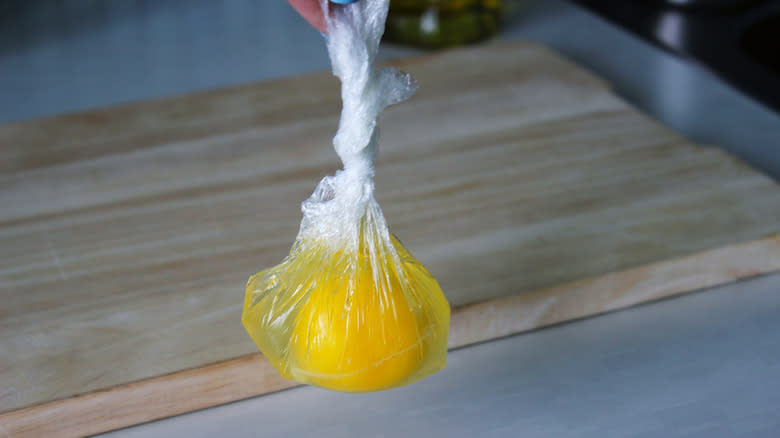
If you're having a bit of trouble getting the right shape for your poached egg, you're not alone: Making sure they have just the right shape is a lifelong endeavor for some. Well, we're all about making years of work the stuff of mere moments here, and that's why we love using cling film for perfect poached eggs. Instead of placing your eggs directly into the pan, you crack them into a ramekin lined with cling film, with a little oil spread over the plastic to stop the egg from sticking. You then wrap the cling film around the egg and tie a knot in the top, before dropping your package into your hot water.
What you'll end up with is a perfectly round egg, with the yolk nestled in the middle, and avoid any feathering or stringiness. Your egg also won't end up too watery, as it doesn't come into contact with the water. Once it's done, just snip the top of the cling film off with a pair of sharp scissors, unwrap the egg, and serve.
Read the original article on Daily Meal

